FFXIV Best Races 2021
| FFXIV Races | Race Change | Race Stats | Race Heights | Race Lifespans |
1. FFXIV Best Race 2021 Ranked
| Races | Popularity | Female | Male |
|---|---|---|---|
| Au Ra | 15.35% | 9.74% | 5.61% |
| Elezen | 7.57% | 2.96% | 4.61% |
| Hrothgar | 0.97% | 0% | 0.97% |
| Hyur | 23.81% | 9.4% | 14.41% |
| Lalafell | 14.81% | 7.02% | 7.79% |
| Miqo'te | 29.61% | 18.5% | 11.12% |
| Roegadyn | 4.82% | 1.29% | 3.54% |
| Viera | 3.05% | 3.05% | 0% |
Buy FFXIV Gil Cheap
- best place to buy FFXIV Gil (6% off coupon: z123). Payment: PayPal, Skrill, Cryptocurrencies.
2. FFXIV Race City Population
| Cities | Elezen | Hyur | Lalafell | Miqo'te | Roegadyn | |||||
|---|---|---|---|---|---|---|---|---|---|---|
| Wildwood | Duskwight | Midlanders | Highlanders | Plainsfolk | Dunesfolk | Seekers of the Sun | Keepers of the Moon | Sea Wolves | Hellsguard | |
| Gridania | 30% | 10% | 40% | 10% | ||||||
| Limsa Lominsa | 10% | 20% | 20% | 40% | ||||||
| Ul'dah | 30% | 10% | 40% | 10% | ||||||
3. List of FFXIV Races
3.1 Elezen
- Clans: Duskwight Elezen & Wildwood Elezen
History
According to their own histories, the Elezen are the original inhabitants of Eorzea, having called the realm home since the First Astral Era—a heritage they take pride in to this day. In those bygone times, they lived a pastoral life on the vast, fertile plains, but were displaced to the outer reaches as their hereditary lands were overtaken by the Hyur, who had migrated to the realm in great numbers. Time and again they waged bloody war against the Hyuran invaders. In time, however, the two races came to a mutual understanding, and they live in harmonious coexistence to this day.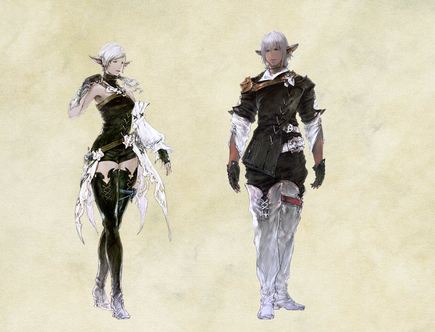
Clans
The two most prominent Elezen clans are the forest-dwelling Wildwood Elezen, who make their home in the Shroud, and the reclusive Duskwight. The former have a long history of cooperation with the Hyur, having jointly formed the forest nation of Gridania, while the latter have long since eschewed contact with other races to pursue their own path in the shadowy seclusion of Eorzea's deep tunnels and caverns. As such, the Wildwood and Duskwight each consider each other traitors to their race, and tensions between the two clans continue to the present day.The Velodyna carp fished from the Hathoeva and Velodyna rivers is a favorite among both clans, and one of the few things both can agree upon.
Identity
Valuing discipline and order above all, and with a natural proclivity for organization and collaborative effort, the Elezen made great contributions in the founding of the city-states of Ishgard and Gridania. That these great nations still stand strong centuries later is a remarkable testament to the Elezen talent for governance. On the other hand, their preoccupation with history and tradition, tendency to relive past glories, and propensity for pretentious speech can occasionally alienate them from other races.The Elezen were also the inventors of archery, and the longbow sentries of the Elezen military gave rise to one of the two most prominent schools of archery in Eorzea.
Tongue
Though the Elezen adopted the common tongue to facilitate communication with their Hyuran allies, the old Elezen tongue is far from a dead language. On the contrary, numerous words from the old tongue have found their way into common parlance, earning a place in the day-to-day vocabulary of other races.Dress
The Elezen tend to favor sharply-cut attire that accentuates their slender physiques. Even their functional adventurers' garb is crafted with an eye for fashion, down to the exquisite silverwork that adorns it. The heightened aesthetic sensibilities of the Elezen are not limited to clothing, and can be observed in their numerous contributions to myriad genres of the fine arts.The Elezen have long been known for their skill in leatherworking, yet for centuries their techniques were heavily guarded. Once they agreed to share their wealth of knowledge, the quality of Gridanian leather goods improved significantly, creating an increased demand for the superior products.
3.2 Hyur
- Clans: Highlanders & Midlanders
- On the First: Hume
History
The Hyur arrived in Eorzea prior to the First Astral Era, when they were but one undistinguished race among many. Three great migratory waves later, the Hyur had spread from the northernmost reaches of Ilsabard to all corners of the realm, expanding their presence and influence to become Eorzea's predominant race, a position they maintain to this very day.As they settled in new frontiers, the Hyur often found themselves in conflict—even outright war—with the native peoples of those lands. Still, none can deny that the knowledge, technology, and ideas they brought with them have served as the driving force behind the rapid spread of culture and civilization in Eorzea.
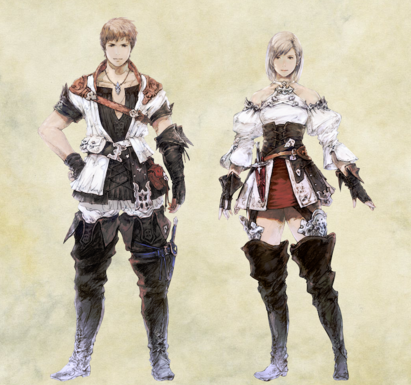
Clans
The Hyur of Eorzea comprise two clans: the Midlanders, who settled in the realm's low-lying regions, and the Highlanders, who claimed the high mountains as their home. This does not, however, represent the entirety of the Hyuran people. Outside of Eorzea, Hyur can be found in Ilsabard in the north, Othard to the east, and even as far as the New World, their manifold clans and houses as innumerous as the stars in the night sky.Identity
The Hyur boast myriad languages and cultural backgrounds rooted in their respective places of origin. On the other hand, lacking a single, overarching culture, and universal Hyuran sense of cultural identity is tenuous at best. Perhaps owing to this, the Hyur are wont to value personal freedom more so than the other races, distinguishing themselves in wide range of disciplines with little concern for tradition or heredity. As such, they can be viewed by other races as overzealous and unprincipled.Tongue
In times of eld, countless tongues and dialects were spoken regularly by the various peoples of Eorzea. As migration and cultural exchange became more common, a universal language arose, easing the burden of communication between different peoples. This language, which came to be known as the common tongue, is now spoken by the vast majority of the realm's residents. It is believed that Hyuran priests also played a vital role in the creation of the Eorzean alphabet at the end of the Fourth Astral Era, though the precise details are lost to history.Dress
The standard attire of Hyuran adventurers is fashioned from cotton fabrics reinforced with leather for a simply yet traditional design. The Hyur also favor leather thighboots, often said to be a vestige from the days of yore when their ancestors crossed the snow-swept plains and harsh peaks of central Ilsabard.3.3 Lalafell
- Clans: Dunesfolk & Plainsfolk
History
Originally an agrarian people hailing from the southern islands, the Lalafell gradually migrated to Eorzea over the years in pursuit of trade. In the Fifth Astral Era, they played a key role in the foundation of the city of Nym on Vylbrand, as well as the mystic city of Mhach in the lowlands of Yafaem. When both civilizations fell to the Sixth Umbral Calamity, the Lalafell were forced to seek new homes. The Nymian Lalafell employed their seafaring talents and returned to the south sea isles, while the survivors of Mhach wandered the lands before eventually settling in the wastes of Thanalan.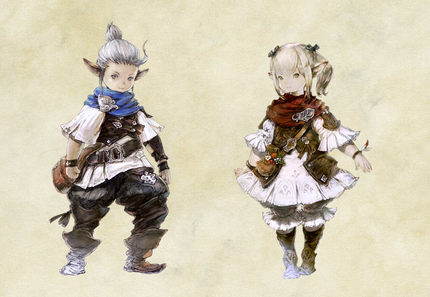
Clans
The Lalafell are primarily composed of two clans: the grassland-dwelling Plainsfolk and the desert-dwelling Dunesfolk, with both tracing their roots to the south sea isles. Though slight differences in physical appearance have emerged over the many generations spent living apart, the two clans harbor no particular resentment for each other, and inter-clan marriages are commonplace, with many Lalafell today possessing both Plainsfolk and Dunesfolk blood.Identity
While placing great importance on familial bonds, the Lalafell are by no means exclusionary. This is manifest in the cordial relations they enjoy with their fellow races, and the success they have achieved as a race of traders and merchants. Though their singularly business-minded nature can lead to them being perceived as greedy and calculating, few can find it in their hearts to truly dislike the Lalafell, with their inherently bright and jovial nature. As such, examples of Lalafell being persecuted by other races are few and far between.Tongue
As befitting their status as a race of traders, the Lalafell were unsurprisingly among the first to adopt and master the common tongue of the Hyur. Nevertheless, it is said that the old Lalafellin tongue is still spoken today on their island homes to the south.Dress
A distinctive element of traditional Lalafellin garb is the scarf, which also serves an eminently practical function—it can be unfurled to serve as a signal flag on the wide seas or vast deserts, allowing a Lalafell to stand out beyond his or her modest stature. They are also known to favor relaxed, loose-fitting garments that conceal their naturally rotund builds.3.4 Miqo'te
- Clans: Keepers of the Moon & Seekers of the Sun
History
The Miqo'te are descendants of a hunting people that crossed over the frozen seas to Eorzea during the Age of Endless Frost, when famine gripped the land. Cleaving to their old way of life, they have largely accepted their status as one of Eorzea's less populous races. Fiercely territorial and proud of their traditions, it could be said that Miqo'te are unsuited to life in the city-states. Nevertheless, as natural-born hunters given to a nomadic lifestyle, many Miqo'te have achieved great success as adventurers.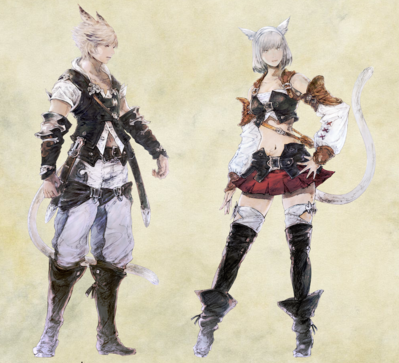
Clans
The Miqo'te are roughly divided into two clans: the diurnal Seekers of the Sun and the nocturnal Keepers of the Moon. The former hunt under the light of day, while the latter prowl at night, and it is believed this stark difference in habit arose due to unique physical differences between the two. Furthermore, within each clan exist numerous tribes, each with their own unique culture, customs, and hunting methods—it can hardly be said that all Miqo'te of the same clan share a common set of beliefs.Identity
A common trait among all Miqo'te is their fierce pride for their heritage as hunters. Seeing themselves as part of the natural world itself, they prize above all the freedom of the hunt, and do not shun death when old age and infirmity sap them of the physical talents needed to pursue their quarry to their satisfaction. To the free-willed Miqo'te, other races' way of life—their wont to flock together with their own kind, to overrun nature with cities, and to seek safety and stability in laws and alliances—must seem quite curious indeed.Tongue
Despite their inherently solitary nature, the Miqo'te adopted the common tongue early on, born of a need to barter with other races to procure materials with which to craft their hunting tools and weapons. Remnants of the old tongue can be observed in the distinctive Miqo'te "huntspeak"—a system of tongue-clicks and whistles used to communicate while in pursuit of quarry.Dress
The agile Miqo'te value freedom of movement above all else, shunning unwieldy armor that might restrict their range of motion. Miqo'te legwear is invariably perforated with a hole through which the tail dangles free, allowing them to maintain their unerring sense of balance.3.5 Roegadyn
- Clans: Hellsguard & Sea Wolves
They for the cultural emphasis they place on competition and unflinching courage. Oft seen vying with one another in feats of strength, they can appear barbaric to the uneducated observer, but in fact are known to be a loyal, honorable and compassionate people and tender, introspective individuals can also be found. The histories are filled with tales of Roegadyn warriors and their courageous deeds.
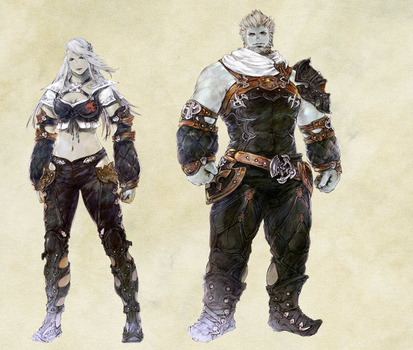
Mythos
The Roegadyn are a maritime folk hailing from the bleak isles of the Northern Empty, their name meaning "people of the rain." According to their mythology, all life first began on the island of Origin, known to them as Nagyn. They still maintain a strong presence in their ancestral home on and around Aerslaent ("First Land" in the old tongue), whence many Roegadyn fled seven centuries ago to free themselves from the reign of a despotic tyrant. As is often told, they came ashore on Vylbrand, and the city of Limsa Lominsa rose to prosperity not long thereafter. Many, many years prior to this, an entirely different group of Roegadyn had crossed over to the continent and settled in the mountains, where their descendants—the Hellsguard—reside to this day.
Clans
The Roegadyn are roughly grouped into two clans: the Sea Wolves, descended from seafaring peoples of the north, and the mountain-dwelling Hellsguard—though those belonging to neither clan can be found elsewhere on the Three Great Continents. This includes Garlemald, where Roegadyn officers can be sighted wreaking havoc on the battlefield in the name of the Empire, having been assimilated under the Garlean yoke. Another group of Roegadyn similar in features to the Hellsguard makes its home in the Far East, where they make up a large portion of the nations of Doma and Hingashi.
Identity
From the angry seas of the Northern Empty to howling mountain peaks, the Roegadyn have historically made their home in rugged, inhospitable climes. Theirs is a culture that exalts the strong and looks down upon the weak, both among their own kind and outsiders. This is by no means limited to physical strength—even a wee Lalafell might win a Roegadyn's respect with a display of mystical power or strength of will. Those who show no such qualities, however, will find it difficult to convince a Roegadyn to so much as give them the time of day without an exchange of coin.
Tongue
While the old Roegadyn tongue lives on in Aerslaent and the Abalathian hinterlands, the Roegadyn of Limsa Lominsa, as well as those who ply their trade as sellswords and adventurers have learned the common tongue, born out of necessity due to their frequent contact with other races.
Dress
Traditional Roegadyn garb is designed as if to flaunt the wearer's imposing physique, with the biceps in particular strikingly exposed. The lower arms are typically covered with sturdy leather armguards with unique cross-stitched patterns, serving to further accentuate the Roegadyn's massive arms.
3.6 Au Ra
- Clans: Xaela & Raen
The curved horns and beautifully patterned scales that characterize the Au Ra oft give rise to speculation that this Hyur-like race native to the Far Eastern continent of Othard are, in fact, the progeny of dragons. This, however, has long been disputed, with scholars citing several distinct differences in the two races as evidence of decidedly dissimilar roots—the first and foremost being the enhanced hearing and spatial recognition granted by an Au Ra's cranial projections (traits not attributed to draconian horns), and the second being the gross disproportion in body mass between Auri males and females (again, a trait widely unseen in dragons).
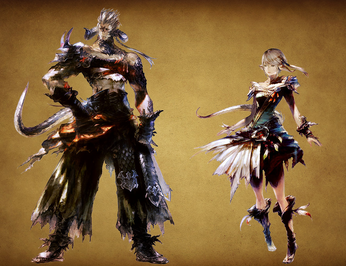
Mythos
Auri creation myth tells of a world formed by the Dawn Father Azim and the Dusk Mother Nhaama. These two deities came to quarrel over which should rule the new world, and created mortals to serve as soldiers in their war by proxy. These were the first Au Ra—the Raen, the children of the Dawn Father, and the Xaela, the chosen of the Dusk Mother. Though they waged a bitter struggle in the name of their creators, they eventually put aside their differences and learned to love one another, giving birth to a new generation. On seeing this, Azim and Nhaama returned to the heavens, leaving the world below in the custody of their children.
Clans
Most widely known among the Auri clans are the Raen and the Xaela. The Raen now make their homes in central Othard and the surrounding islands, where they have forged strong relations with the Hyur and other races, adapting readily to new cultures. The Xaela, on the other hand, live still today on the vast Azim Steppe, clinging tenaciously to their traditional, nomadic way of life.
Identity
Possessed of a strong self-preservation instinct, the Au Ra believe in protecting tribe and family, though the means by which the two clans choose to do so diverges greatly. The Raen coexist peacefully with other races to ensure the safety of their own kind, while the fiercely tribal Xaela shun relations with other races, even viewing strangers of their own kind as potential enemies. As such, the former are viewed more favorably by the outside world, while the latter are typically regarded with suspicion and hostility.
Tongue
On the steppes which they call home, the Xaela speak the old Auri tongue to this day. The Raen, however, having assimilated to Far Eastern culture, have adopted the common tongue of the Hyur. Their spoken language differs some from that spoken in Eorzea, which leads many to perceive it as a slightly odd dialect.
Dress
Most unique and striking among the traditional dress of the Au Ra are their belts, which feature prominent scale-shaped patterns. Inspired by the hardened skin of the Au Ra themselves, they symbolize health and vitality. While the sleeves appear as if they have been indiscriminately ripped apart, this too is an age-old tradition meant to evoke an air of rugged strength.
3.7 Viera
- Clans: Rava & Veena
Introduced in Shadowbringers, the Viera can be played as female only.
Male Viera will be added with Endwalker.
Viera are divided into Rava and Veena clans.
History
For centuries, even since the age of Ivalice, many Viera tribes have remained hidden in the jungles, content with their self-imposed solitude. Efforts by past kings to bring Viera lands under Dalmascan rule were all met either by indifference or violence, and the nation ultimately suffered the Viera their self-governance, with the promise their villages would not take up their bows against the throne.
It was not until the past several generations that a Viera living outside of her homeland was unheard of, yet recently more and more of the leporine women have abandoned their ancestral homes for the comforts of the cities. Those Viera who have done so tend to be held in high regard, their small numbers lending them an air of mystery with some members of the upper class paying large sums to be seen with one of their kind.
Thirty years ago, when the Garlean Empire occupied Dalmasca, several imperial army units were sent into Golmore Jungle to round up Viera and bring them to Rabanastre. Though only a few of the soldiers returned, the few Viera with them appeared to have followed on their own volition. However, while the Viera had long been treated as equals by the Dalmascans, like any not of the pureblood Garlean race, they have been relegated to life as second-, or even third-class citizens, a change that has proved especially difficult for the Viera who left their forests in pursuit of freedom.
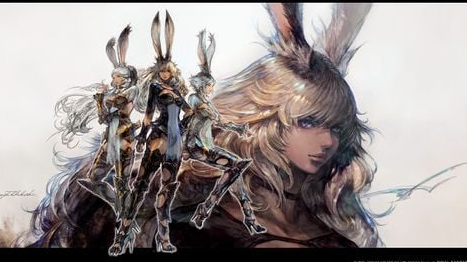
Clans
The Viera are roughly divided into two clans. The Rava live primarily in the lush, colorful Golmore Jungle, distinguished by their melonated skin, while the Veena have paler skin, who reside in the mountains of the Skatay Range that rise above their forest home in its foothills. Members of both clans have become more common in cities such as Rabanastre in the past few generations.
3.8 Hrothgar
- Clans: Helions & The Lost
Introduced in Shadowbringers, the Hrothgar can be played as male only.
Female Hrothgar will be added some time after the release of Endwalker.
Hrothgar are divided into Helions and The Lost clans.
Hailing from the distant shores of Ilsabard, the Hrothgar are a burly people of lionlike appearance—or the males are, at least. Females number staggeringly few among their population, and thus are rarely so much as glimpsed by the other races.
The Hrothgar's imposing countenance─mitigated not at all by their sharp claws and still sharper fangs—incited panic amongst Eorzeans upon their arrival. As they were also unable to communicate, initial interactions with the commonfolk often escalated into conflict. It was not until the Hrothgar gained mastery of the common tongue that fears were allayed, and in time they would be as neighbors, welcome in all corners of the realm.
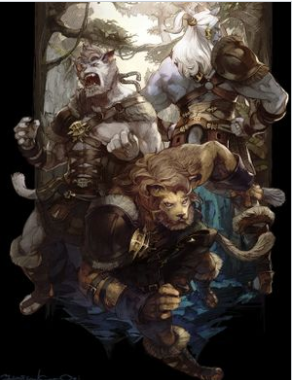
Guides & Tips
- PoE Blood Ritual Debuff 3.13
- Careful Handling PoE
- Anomalous Ambush PoE
- Swift Skewering PoE
- Death Rush PoE Build & Price – Amethyst Ring
- Anomalous Spectral Shield Throw PoE
- Anomalous Meat Shield Support PoE
- The Journey Continues – FFXIV
- Aerialist PoE
- PoE Shaper Fragments, How to Get Shaper Map Fragments
- Divergent Infernal Blow PoE
- Sambodhi’s Vow Divination Card PoE – Farming Mortal Fragment
- Emperor’s Cunning PoE Farming Build 3.14
- Harness the Void PoE
- Escaped Experiment PoE